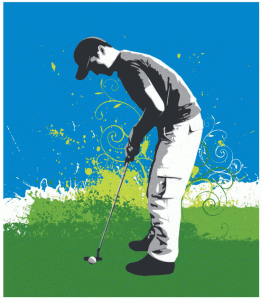The Three Swings of Wright Balance: Which One Are You?
USGTF Contributing Writer, Oakland, California
Our 25 years of research has yielded the following: In summary, we are able to do simple body measurements, provide a student with stance widths that recruit different “core regions, “and match stance widths, posture and grip to their playing core region for maximum power and consistency. There are three ways to swing a golf club. These swings come out of one of our three core regions.
The following is an illustration of nine core regions that are identified by a printout from the results of the measurements of stance widths that recruit precise core regions. Each core region has different stance widths, posture, grip and swing characteristics.
The nine core regions within three main core regions
These nine core regions relate to one of three golf swings as follows:
Lower Core Swing
The “lower core,” regions 1, 2 and 3, entails the area from the navel to the pelvic floor. Players in this region have the widest stance width of all players. They “test” for greater strength in their lower body and they have the ability to place their trail arm inside their hip in the downswing. Lower core players are body swingers. They have the strongest grip, the greatest shaft lean, and the greatest trail shoulder tilt at address. When we measure the posture angles of the lower core player, their spine angle and thigh angles are equal. Their spine and thigh angles are 151 degrees or less when measured 90 degrees to the ground. Their ball position is center to center- back to accommodate the greater shaft lean. The butt of the club of the lower core player will point toward the target-side thigh.
The lower core player has a short thumb due to gripping the club so that the bottom of the grip crosses the second pad up on the middle finger of both the left and right hands. This grip “in the fingers” is what produces the greater shaft lean and stronger grip. Shaft lean is a natural position produced by the grip.
The lower core player starts the sequencing of the backswing with their upper core as the shoulders, arms and hands turn as one unit. Their trail hip turn is deep and the target-side knee points to the front of the ball. The wider stance width facilitates a restriction of the hips in the backswing. The lower core player has the greatest separation of the upper and lower body in their backswing. The plane of their shoulders approximates level at the top of their backswing and/or they sit down and level their shoulders before starting the club down, similar to Dustin Johnson and Jordan Spieth. Their center of mass is over their trail hip at the top of their backswing and their trail hand is “under,” with the forearm of that trail arm perpendicular to the ground.
In the downswing, the lower core player begins with a rotation of their hips and their shoulders, then the arms and hands follow, just the opposite of the backswing sequence. The trail elbow is seated inside the trail hip in the downswing, similar to Ben Hogan, and the shaft plane crosses the trail arm and drops further as the butt of the club points at the lower core at impact. The hips are 75 to 90 percent cleared at impact and the delivery to the ball is under, with an extension of the clubhead down the line.
The lower core player’s balance is over the center of their arches at address and through the swing. This is an important point we will revisit. Again, note that the lower core player’s balance is over the center of their arches. The lower core player gets their power from the ground using linear (horizontal) and torque (rotational) ground force with minimal to no vertical forces through
their swing.
Ben Hogan is the poster person of the lower core player. His swing was the model for many teachers for decades, myself included. And why not? A player of Hogan’s caliber should be emulated, but maybe not. Read on and you begin to see how unique each of us is.
Current lower core tour players include Johnson, Spieth and Paula Creamer. In spite of the proliferation of Hogan’s model, lower core players are rare in men. I am a lower core player. My legs were always the strongest part of my body and still test the strongest to this day. Lower core players are more often found in women players due to the fact that the greatest lean muscle mass in women is in the middle and lower core. Men, as a rule, have greater lean muscle mass in their upper core. Our research shows that the lower core male is a rare breed. Out of 90 elite male players and 10 elite female players in a study of ground reaction force one of my colleagues is doing, he found six percent tested strongest in their lower core. If he had an equal number of women in this study, we would find that the majority of the women would be lower and middle core players.
The upper core, regions 7, 8 and 9, includes the base of the sternum to the neck. Players in this region have the narrowest stance widths, the least amount of shaft lean and a forward ball position. Their stance width is well inside their shoulders. The upper core player’s shaft lean is just inside the interior groin of the target-side leg, closer to their midline than their target side thigh.
The upper core player has a long left-hand thumb due to gripping the club so that the grip crosses the first pad up next to the palm on the middle finger of both the left and right hands. This grip position is what produces the minimal shaft lean and weaker grip. Shaft lean is a natural position produced by the grip.
The upper core players “test” for greater strength in their upper body and their trail arm will only “seat” at the side of the rib cage when tested, much less than the lower core player. The upper core player is unable to seat their trail arm inside their hip in the downswing. Their trail elbow is outside the trail hip on their side. Upper core players are arms and hands swingers. Their weak grip and grip position produce the least shaft lean and the least trail shoulder tilt at address of all the players.
When we measure the posture angles of the upper core player, their spine angle is much greater than their thigh angle. The thigh angle measures 158 degrees or greater at address.
The upper core player starts the sequencing of their backswing with both their upper and lower body. Their trail hip turn is deep and the target- side knee points well inside the back of the ball. The upper core player has the greatest hip turn and the least separation of the upper and lower body at the top of their swing, and the plane of their shoulders is vertical. Their center of mass is over their target side at the top of their backswing and their trail hand is on top of the grip, with the forearm of that trail arm “flying,” two things I attempted to “fix” in too many players. When I would see that upper core players with their center of mass on the target side, I believed that was a “reverse pivot” and the “flying” trail elbow, I believed, needed to be inside that target-side hip, just like Mr. Hogan. Why not? That worked for Mr. Hogan and for me. Why not everybody else? Fortunately, the great upper core players did what was “natural” for them. They use terms like covering the ball and release of the arms and hands.
In the downswing, the upper core player is already target side. They begin with a rotation of their shoulders and hips. Many upper core players will describe a feeling of an “over the top” swing as they begin to work on their new motion. The trail elbow is “outside” the trail hip in the downswing. As the hips reach parallel to the target line, there is a change of direction upward, and the upper core player often comes out of posture, rising through impact. The hips have minimal clearance at impact due to the direction change upward and also due to their balance being on the balls of their feet. The arms and hands lead and exit quickly left in the release of the club. The club points at the upper core at impact. Rising through impact is a must for the upper core player. If you tell an upper core player to stay in their posture through impact, you will see an immediate power leak.
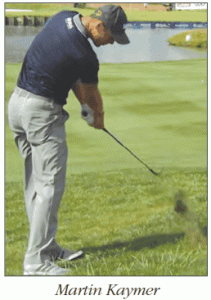 The upper core player’s balance is over the balls of their feet at address and through the swing. This is an important point we will revisit. Again, note that the upper core player’s balance is over the balls of their feet. The upper core player gets their power from the ground using torque (rotational) and vertical ground force. The upper core player has very little, if any, linear/horizontal motion in their golf swing as they load to their target side with a big trail hip turn, elbow out and on top position at the top of their backswing.
The upper core player’s balance is over the balls of their feet at address and through the swing. This is an important point we will revisit. Again, note that the upper core player’s balance is over the balls of their feet. The upper core player gets their power from the ground using torque (rotational) and vertical ground force. The upper core player has very little, if any, linear/horizontal motion in their golf swing as they load to their target side with a big trail hip turn, elbow out and on top position at the top of their backswing.
Current upper core tour players include Patrick Reed, Martin Kaymer, Phil Mickleson and a significant percentage of those playing the PGA Tour now. The only upper core women’s tour player I have seen is Laura Davies. Upper core players are rare in women.
Middle Core Swing
That leaves us with the middle core player. The middle core player is the hybrid. They have characteristics of the upper and lower core player. They have the “gold standard” swing. The middle core, regions 4, 5 and 6, entails the area from the navel to the base of the sternum. Players in this region have a stance width in between the upper and lower core players. They “test” for greater strength in their middle body around their torso and they do not have the ability to place their trail arm inside their hip in the downswing. Middle core players are both body swingers and arms and hands swingers.
The middle core player has a “neutral” grip, with the bottom of the grip crossing the first knuckle joint of the middle fingers of the left and right hands. This grip position produces a neutral grip, and their shaft lean is between the upper and lower core player, as is their stance width.
When we measure the posture angles of the middle core player, their spine angle is slightly greater than their thigh angle. Their thigh angle measures between 152 and 158 degrees, generally in the 154 to 156 range. Their trail arm seats just at the trail hip in the downswing.
The middle core player starts the sequencing of the backswing for the first 12 inches or so with their upper core as the shoulders, arms and hands turn as one unit, then the hips release. Their hip turn is greater than the lower core but less than the upper core. Their target side leg points just inside the back of the ball. The middle core player has separation of the upper and lower body between the lower and upper core in their backswing. The plane of their shoulders is “neutral” at the top of the backswing. Their center of mass is centered over the pelvis at the top of their swing. Their trail hand is on the side of the grip at the top of the swing, and their trail forearm is perpendicular to slightly “out,” relative to the ground.
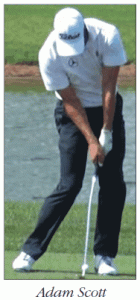 In the downswing, the middle core players begin with a rotation of their hips, and their shoulders, arms and hands follow, just the opposite sequence of the backswing. The downswing shaft plane crosses the middle core and the butt of the club points at the middle core at impact. The trail elbow is seated at the trail hip in the downswing. The hips are 45 to 60 percent cleared at impact and the delivery to the ball is on the side with a release 45 degrees (diagonally) to the target line.
In the downswing, the middle core players begin with a rotation of their hips, and their shoulders, arms and hands follow, just the opposite sequence of the backswing. The downswing shaft plane crosses the middle core and the butt of the club points at the middle core at impact. The trail elbow is seated at the trail hip in the downswing. The hips are 45 to 60 percent cleared at impact and the delivery to the ball is on the side with a release 45 degrees (diagonally) to the target line.
The middle core player’s balance is just forward of the center of the arches and behind the balls of the feet at address and through the swing. This is an important point we will revisit. The middle core player gets their power from the ground using linear (horizontal), torque (rotational) and vertical ground force, all three power sources.
Current middle core Tour players include Adam Scott, Jon Rahm, Jason Day, Ernie Els and Justin Thomas. LPGA Tour players are middle and lower core. Each of these middle core players share a bit of upper and lower core characteristics.
Balance Points of the Different Core Regions
Now let’s revisit the points of balance in each of these core regions. Everything I have described here is related to balance. The lower core player is over the center of their arches and their ball position is center-back in their stance. Without a club, and with a ball on the floor or ground center-back in a wide stance, set up in a posture so your weight is over the center of your arches. Turn your trail hand so your palm is angled up toward the ceiling at a 45 degree angle. Now, turn back to the top of the swing with your weight still over the center of your arches and your trail hand in that “strong” position. Notice that your center of mass is over your trail hip side. Now start your downswing with your hips and notice how easily your hips turn through to finish in that center of arches position.
Now let’s go to the balance and setup positions of the upper core player. Set your weight over the balls of your feet, move the ball forward and narrow your stance. Now turn your trail hand to a “weaker” position so that it is angled toward the floor at a 45 degree angle. Now, turn in your backswing with your weight over the balls of your feet and your trail hand angled down with a forward ball position. Don’t fight staying on the target side. That is where your center of mass is going, so let it go. If you “move off” the ball as your first move, you won’t feel that target-side center of mass. Just rotate around that forward ball position. Remember, the upper core player uses rotational and vertical ground force. You have the rotational force in your backswing and downswing. Let’s find the vertical force. Stay on the balls of your feet and start your downswing. Notice how your hips “stall” at impact and you change direction moving upward. There’s your vertical ground force. Notice how quickly your arms and hands exit left as they pull your hips through. Also notice the feeling of “covering” the ball.
Lastly, let’s go to the middle core motion. Set your stance width just inside your armpits. Move your ball center to center-forward in your stance. With a flat palm, point the fingers of your trail hand straight ahead so that your trail hand is perpendicular to your body. Set your trail arm elbow just forward of the middle of your body and on your trail hip with your fingers still pointed straight ahead. This is a “neutral” trail-hand grip position. Set your weight just forward of the center of your arches and just behind the balls of your feet.
Now with your fingers pointed straight ahead, slowly begin your backswing with your shoulders, arms and hands. When your trail hand reaches 30 to 40 degrees to your target line, release your hips and continue turning. You should feel very centered in your backswing over your pelvis. Now turn through to the finish starting with your hips, keeping your balance just forward of the center of your arches and behind the balls of your feet. You will notice a release of your hips that is greater than the upper core swing and less than a lower core swing. You may notice minimal lateral motion back to the ball and a tendency to come up and out of posture. Notice that you are somewhere between the feeling of an upper and lower core impact position. The middle core player uses the ground in all three forces, linear or horizontal, torque or rotational, and vertical or launch.
If you are interested in exploring more about Wright Balance as it applies to your playing or teaching, take a look at the e-book on the homepage at www.WrightBalance.com. You will find the history and the brain trust behind the research and several hundred pages of illustrations of tour players from upper, middle and lower core regions.
USGTF honorary member David F. Wright, Ph.D., holds two doctorates. His areas of specialization are in research, the psychology of learning and psychophysiology. He was a member of the full-time faculty of the University of Southern California School of Medicine for four years and he has been a member of the clinical faculty of the School of Medicine for over 25 years. Dr. Wright has been a golf teaching professional since 1982. He is the author of four books on golf and numerous golf magazine and professional journal articles, videos and audio CDs. Dr. Wright conducted a three-year golf research project in Dr. Frank Jobe’s biomechanics lab at Centinela Hospital in Los Angeles from 2004 through 2007. He has been described by Sports Illustrated and Golf Magazine as the “balance expert” and in Golf Digest of Japan as the “foremost expert on balance” and “…leader in balance instruction across all sports and industries.”


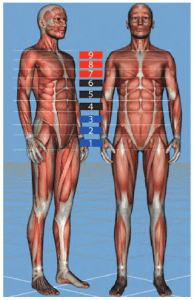
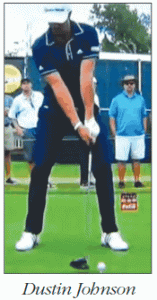
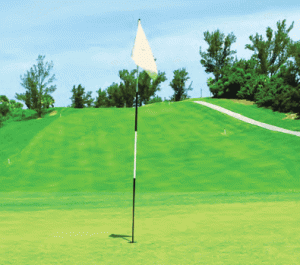
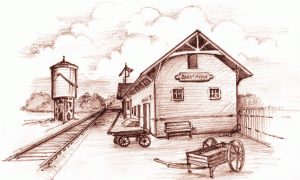 Tucked away in our subconscious is an idyllic vision. We see ourselves on a long trip that spans the continent. We are traveling by train. Out the windows we drink in the passing scene of cars on nearby highways, of smoke pouring from a power plant, of row upon row of corn and wheat, of flatlands and valleys, of mountains and rolling hillsides, of city skylines and village hills.
Tucked away in our subconscious is an idyllic vision. We see ourselves on a long trip that spans the continent. We are traveling by train. Out the windows we drink in the passing scene of cars on nearby highways, of smoke pouring from a power plant, of row upon row of corn and wheat, of flatlands and valleys, of mountains and rolling hillsides, of city skylines and village hills.
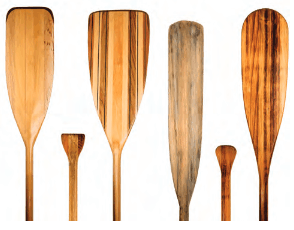 By Norm Crerar, USGTF Contributing Writer
Vernon, British Columbia
By Norm Crerar, USGTF Contributing Writer
Vernon, British Columbia
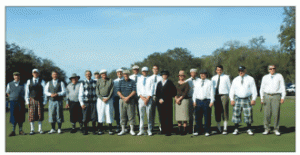 By Mike Stevens USGTF Member, Tampa, Florida
By Mike Stevens USGTF Member, Tampa, Florida
 By Dr. Gregg Steinberg USGTF Sports Psychologist, Nashville, Tennessee
By Dr. Gregg Steinberg USGTF Sports Psychologist, Nashville, Tennessee
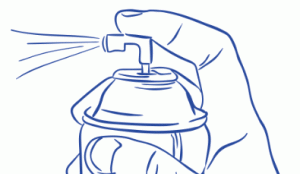 By Larry Van House, USGTF Member, Camp Hill, Pennsylvania
By Larry Van House, USGTF Member, Camp Hill, Pennsylvania
